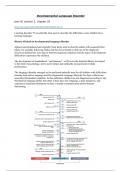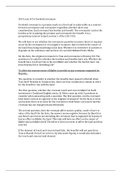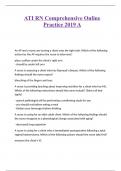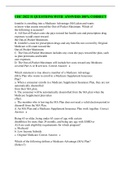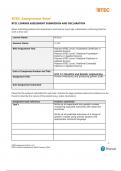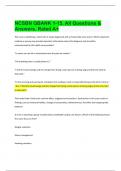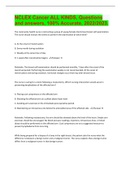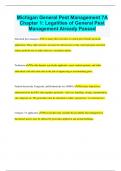Developmental Language Disorder
part IV, section 1, chapter 35
https://doi.org/10.1093/oxfordhb/9780198786825.013.35
Learning disorder un umbrella term used to describe the difficulties some children have
learning language.
History of labels in developmental language disorder
Aphasia and dysphasia had originally been terms used to describe adults with acquired brain
injury, for example following stroke and they have tended to drop out of the diagnostic
lexicon as distinctions were drawn between acquired conditions and the types of development
difficulties experienced by children.
The development of standardized ‘’performance’’ or IQ tests (the Stanford Binet) developed
in the field of psychology, led to more formal and replicable measurement of child
performance.
The language disorder emerged as the preferred umbrella term for all children with difficulties
learning their native language and Developmental Language Disorder for those without any
associated biomedical condition. In this definition children are not diagnosed according to any
threshold in language ability but rather if they have low language, a poor prognosis, and
experience functional limitations in their everyday communication and/or broader
functioning.
, The prevalence of language disorder in different social quintiles
Prevalence rate increases as the level of social disadvantage increases.
Prevalence of 50% in four-year-old children in nursery in very disadvantaged areas of
Sheffield whom were in the lowest Index of Multiple Deprivatio.
Comorbidity and co-occurring difficulties
In a sample of seven-year-old children, those with low language abilities were more likely
than their typically developing peers to have associated difficulties with literacy,
socioemotional, and behavioral adjustment, hyperactivity, and inattention, lower non-verbal
IQ and diagnoses of autistic spectrum condition.
A key area of debate with respect to the diagnosis of specic language disorder is the role
played by non-verbal IQ (een belangrijk discussiepunt met betrekking tot de diagnose van een
specifieke taalstoornis is de rol van non-verbaal IQ).
There is no dfferences found between four to five-year-old children with Language Disorder
with average and low-average non- verbal scores with respect to the severity of language
impairment, social, emotional, and behavioral problems, or educational attainment.
It seems that the effects of IQ were minimal or IQ does not affect children’s response to
intervention.
Socioemotional difficulties and poor language abilities co- occur at rates much higher than
chance. A variety of views have been expressed about whether they are causally related, for
example, do children frustrated from poor communication skills, act out and respond in a
negative manner, or is there a third factor such as neurodevelopmental immaturity or marked
social disadvantage which effectively accounts for both domains? A number of other
mechanisms have been proposed:
- The relationship between language and literacy is the key to understanding behavior
- It is pragmatics rather than structural language which is key
- Because language can vary so much across childhood that it is the language trajectory
rather than ability at any one time point which is critical.
part IV, section 1, chapter 35
https://doi.org/10.1093/oxfordhb/9780198786825.013.35
Learning disorder un umbrella term used to describe the difficulties some children have
learning language.
History of labels in developmental language disorder
Aphasia and dysphasia had originally been terms used to describe adults with acquired brain
injury, for example following stroke and they have tended to drop out of the diagnostic
lexicon as distinctions were drawn between acquired conditions and the types of development
difficulties experienced by children.
The development of standardized ‘’performance’’ or IQ tests (the Stanford Binet) developed
in the field of psychology, led to more formal and replicable measurement of child
performance.
The language disorder emerged as the preferred umbrella term for all children with difficulties
learning their native language and Developmental Language Disorder for those without any
associated biomedical condition. In this definition children are not diagnosed according to any
threshold in language ability but rather if they have low language, a poor prognosis, and
experience functional limitations in their everyday communication and/or broader
functioning.
, The prevalence of language disorder in different social quintiles
Prevalence rate increases as the level of social disadvantage increases.
Prevalence of 50% in four-year-old children in nursery in very disadvantaged areas of
Sheffield whom were in the lowest Index of Multiple Deprivatio.
Comorbidity and co-occurring difficulties
In a sample of seven-year-old children, those with low language abilities were more likely
than their typically developing peers to have associated difficulties with literacy,
socioemotional, and behavioral adjustment, hyperactivity, and inattention, lower non-verbal
IQ and diagnoses of autistic spectrum condition.
A key area of debate with respect to the diagnosis of specic language disorder is the role
played by non-verbal IQ (een belangrijk discussiepunt met betrekking tot de diagnose van een
specifieke taalstoornis is de rol van non-verbaal IQ).
There is no dfferences found between four to five-year-old children with Language Disorder
with average and low-average non- verbal scores with respect to the severity of language
impairment, social, emotional, and behavioral problems, or educational attainment.
It seems that the effects of IQ were minimal or IQ does not affect children’s response to
intervention.
Socioemotional difficulties and poor language abilities co- occur at rates much higher than
chance. A variety of views have been expressed about whether they are causally related, for
example, do children frustrated from poor communication skills, act out and respond in a
negative manner, or is there a third factor such as neurodevelopmental immaturity or marked
social disadvantage which effectively accounts for both domains? A number of other
mechanisms have been proposed:
- The relationship between language and literacy is the key to understanding behavior
- It is pragmatics rather than structural language which is key
- Because language can vary so much across childhood that it is the language trajectory
rather than ability at any one time point which is critical.


